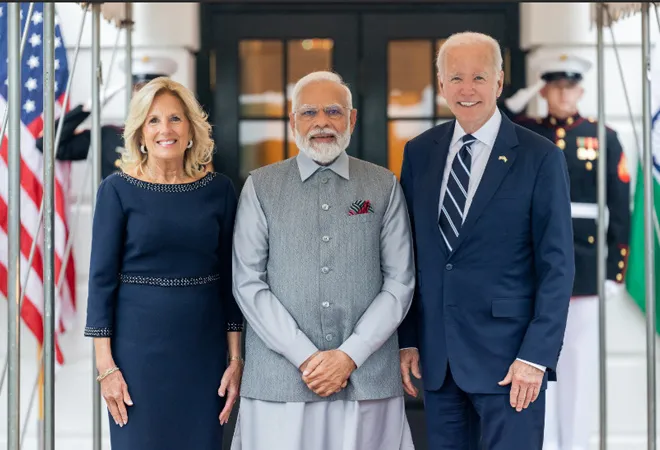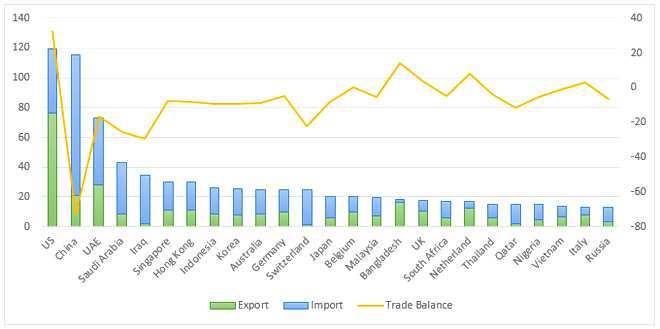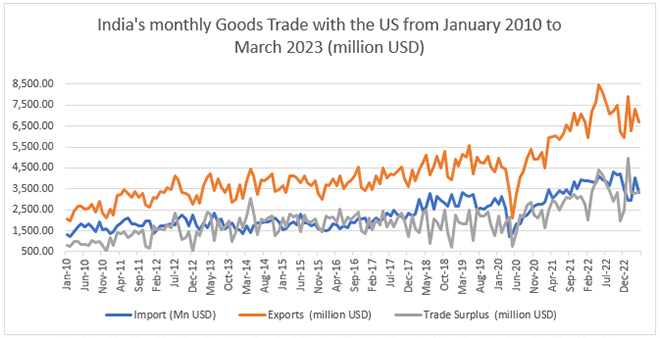
The India-United States (US) trade relationship has gained significant momentum over the last two years. Whether COVID-19 has been a driver of this phenomenon is debatable, but the period of growth somehow converges with the post-pandemic recovery phase of the world. Since FY 2021-22, the US has been India’s
largest trading partner surpassing India’s aggregate trade volumes with traditional trade partners like China and the United Arab Emirates (UAE). From US$ 80.51 billion in FY 2020-21 to US$ 119.5 billion in FY 2021-22, India’s bilateral trade with the US witnessed a significant 48.4 percent increase year-on-year. Provisional
estimates from the Ministry of Commerce and Industry suggest that the growth momentum in India-US trade remained afloat with a 7.65-percent increase to US$ 128.55 in FY 2022-23. Among its few major trading partners with whom India shares a trade surplus, the share of its surplus with the US is the largest.
Figure 1: India’s Top Trading Partners FY 2021-22 (US$ Billion)
 Source: Trade Statistics, Ministry of Commerce and Industry, Government of India
Source: Trade Statistics, Ministry of Commerce and Industry, Government of India
As such, India’s goods trade with the US in terms of exports, imports, and trade surplus have been revealing a secular increase over time as can be seen in Figure 2.
Figure 2: India's monthly Goods Trade with the US from January 2010 to March 2023 (US$ Millions)
 Source: https://www.census.gov/foreign-trade/balance/c5330.html
Source: https://www.census.gov/foreign-trade/balance/c5330.html
Further, during FY2020-21, Foreign Direct Investments (FDI) flow recorded a new high for India amounting to US$ 81.72 billion, with the US contributing 17.94 percent of the same as the second biggest source. It is interesting to note that all these developments emerged at a time when the global trade landscape is witnessing a paradigm shift, with the rise of the ‘China+1’ (C+1) strategy. The ‘C+1’ strategy has gained traction as businesses seek to
diversify their manufacturing and sourcing away from overreliance on China. This approach involves establishing alternative production bases in countries like India to mitigate risks associated with concentrated supply chains and create access points to new and growing markets.
The China+1 landscape and opportunities for India-US trade
The congruence in timelines of the deepening economic ties between the US and India, and the aversion of global markets to shift production away from China to other emerging markets in its immediate neighbourhood clearly points to the opportunities that the ‘C+1’ landscape presents for India. With its vast consumer base, skilled workforce, and investor-friendly policies, India has emerged as an
attractive destination for foreign investments in manufacturing and services. This will likely further boost India’s trade relations with major partners like the US.
India can leverage its strengths in various sectors, including information technology, pharmaceuticals, textiles, and automotive, to attract American businesses looking to expand their presence beyond China.
The India-US trade relationship stands to benefit significantly from the ‘C+1’ landscape. Shifting production facilities and supply chains to India presents immense opportunities for both countries.
Media reports state that the government, through its overseas missions, has reached out to over 1,000 US companies seeking to move their manufacturing base from China. India can leverage its strengths in various sectors, including information technology, pharmaceuticals, textiles, and automotive, to attract American businesses looking to expand their presence beyond China. Additionally, India's ambitious initiatives like “
Make in India” and “
Digital India” align with the US focus on reshoring and boosting domestic manufacturing, providing a solid foundation for collaboration.
Furthermore, the India-US synergy extends beyond trade in goods. Services, such as IT outsourcing, software development, and business process management, have been integral to the India-US bilateral trade relationship. The US has been a
significant market for Indian services exports, and the evolving dynamics of the ‘C+1’ strategy can further enhance these trade opportunities. With their complementary strengths and shared focus on innovation, India and the US can forge closer ties in the services sector, opening avenues for growth and job creation in both countries.
The burgeoning India-US trade relationship holds immense potential for the future. As the US emerges as India's largest trading partner, the economic ties between the two nations are poised to grow stronger. The opportunities presented by the China+1 landscape, coupled with the bilateral collaborations in various sectors, lay the foundation for a mutually beneficial trade relationship.
With their complementary strengths and shared focus on innovation, India and the US can forge closer ties in the services sector, opening avenues for growth and job creation in both countries.
However, some challenges need to be addressed to ensure sustained growth. Issues such as trade barriers, intellectual property rights, regulatory harmonisation, and market access must be tackled through constructive dialogue and negotiations. A balanced and fair trade environment will foster trust and confidence, enabling businesses to seize available opportunities.
Strengthening India-US Trade: PM Modi's Visit to the US
Given this backdrop, Prime Minister Narendra Modi's current visit to the US holds immense significance for the future of India-US trade relations. This visit serves as a platform to reinforce existing partnerships and establish new avenues of cooperation. The discussions between Prime Minister Modi and US leaders are expected to focus on
key areas, including technology collaboration, health, education, defence ties, and renewable energy.
In the technology sector, both India and the US have thriving tech ecosystems and are
leaders in innovation. Collaborations in areas such as artificial intelligence (AI), cybersecurity, and digital infrastructure can further strengthen their partnership. This can lead to joint research and development initiatives, technology transfers, and increased investment flows, fostering mutual growth and competitiveness. Leveraging these innovations in the tech sector and the flourishing digital economy space, the India-US trade
collaboration in health (for affordable healthcare and medicines) and education ( for campus-to-campus relations and joint research work) sector may witness a significant uptick.
India-US is all set to close an acquisition deal on 31 predator drones—such collaborations not only enhance defence capabilities but also contribute to economic growth through joint ventures and offsets.
Defence cooperation has been a cornerstone of India-US relations, with defence trade between the two countries experiencing significant growth. Prime Minister Modi's visit presents an opportunity to deepen defence ties, including defence equipment procurement, joint exercises, and technology transfers. India-US is all set to close an
acquisition deal on 31 predator drones—such collaborations not only enhance defence capabilities but also contribute to economic growth through joint ventures and offsets.
Another crucial aspect of the visit is
renewable energy cooperation. Both India and the US recognise the urgency of addressing climate change and transitioning to a sustainable future. Collaborative efforts in renewable energy research, development, co-production and deployment can create significant business opportunities and help achieve shared environmental goals. This can include investments in clean energy projects, technology transfers, and knowledge sharing to drive the green transition.
The US emerging as India's largest trading partner marks a significant milestone in their economic relationship. The China+1 strategy has played a pivotal role in reshaping global trade dynamics, with India emerging as a key beneficiary. The visit of Prime Minister Modi to the US further solidifies the foundation of the India-US trade relationship, opening doors for collaboration across sectors.
While definitely, China happens to be a common source of contention for both the US and India from both geopolitical and geoeconomic perspectives, PM Modi’s visit is a reinforcement that bilateral engagements as also engagements in multilateral forums need to emerge to be a “win-win” solution for both nations. On the one hand, Indian exports find a ready product market in the US which is largely a “consumptive economy” (an economy with high consumption propensity and high purchasing power). On the other hand, the US economy finds a cheap, abundant factor market in India that presents itself with massive potential. India’s demographic dividend lies in its cheap skilled labour force with labour costs being 10 per cent of those of China. On the other hand, the massive facelift in India’s physical infrastructure in recent years has reduced the transaction cost of doing business.
India’s demographic dividend lies in its cheap skilled labour force with labour costs being 10 per cent of those of China.
The Indo-Pacific Economic Forum (IPEF), an economic initiative launched by the Biden administration with a total of fourteen participating founding member nations including India again presents a massive opportunity for India in case there is a possibility for developing the Forum into a Regional Trade Agreement framework. This is because of two reasons: first, this forum is devoid of China thereby resulting in a China-free RTA; second, if it at all comes to force, it can highly compensate for India’s withdrawal from the Regional Comprehensive Economic Partnership (RCEP) that has often been thought as a lost opportunity for India to provide access of its MSMEs to unexplored markets.
The “economic complementarities” in the forms of trade and investment between the US and India are extremely evident from what we discussed in this essay. By harnessing the opportunities presented by the ‘China+1’ landscape and nurturing a balanced and fair-trade environment, both countries can forge a formidable partnership that drives economic prosperity and strengthens their broader strategic ties. As the curtain rises on this new chapter with PM Modi’s visit, the stage is set for a thriving trade relationship between the two large democracies of the world.
Nilanjan Ghosh heads the Centre for New Economic Diplomacy (CNED) and the Kolkata Centre at ORF.
Debosmita Sarkar is a Junior Fellow with the Centre for New Economic Diplomacy at the Observer Research Foundation
The views expressed above belong to the author(s). ORF research and analyses now available on Telegram! Click here to access our curated content — blogs, longforms and interviews.



 The India-United States (US) trade relationship has gained significant momentum over the last two years. Whether COVID-19 has been a driver of this phenomenon is debatable, but the period of growth somehow converges with the post-pandemic recovery phase of the world. Since FY 2021-22, the US has been India’s
The India-United States (US) trade relationship has gained significant momentum over the last two years. Whether COVID-19 has been a driver of this phenomenon is debatable, but the period of growth somehow converges with the post-pandemic recovery phase of the world. Since FY 2021-22, the US has been India’s 

 PREV
PREV



